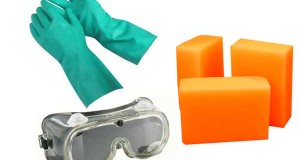Soap Ingredients
in Soap Info
October 27, 2013
3704 Views
- Oils:
- 24 ounces olive oil (not extra virgin)
- 24 ounces coconut oil
- 38 ounces vegetable shortening
- Alkaline Solution:
- 12 ounces lye
- 32 ounces spring or distilled water
- Fragrance or essential oil
- 4 ounces of your favorite fragrance
- Equipment:
- Safety goggles
- Rubber gloves
- Scale to weigh the ingredients
- Large stainless steel or enamel kettle; not aluminum, and not lined with non-stick surface
- Glass or plastic wide-mouth pitcher to hold water and lye
- Two-cup plastic or glass measuring cup
- Plastic or wooden spoons
- Stick blender (optional)
- Two glass thermometers that registers between 80-100 degrees F
- Plastic molds that are marked suitable for cold process soapmaking, or a plastic shoe box, or a wooden mold.
- Parchment paper
- Multiple towels
- A source of running water and vinegar, in case of contact with lye.
Tips
- Temperature is crucial when mixing the oils with the lye. If they are too hot, they will separate; if they are too cool, they won’t turn into soap.
- Lye can be found in the plumbing section of most hardware store or purchased online. Make sure the package says it is 100% sodium hydroxide.
- Don’t use perfume as a fragrance, especially if it contains alcohol. It will alter the chemical reaction that’s taking place between the lye and the fats, and will cause your soap to fail. You can use natural essential oils or fragrances that are specifically manufactured for use in soaps. A little bit of essential oil or fragrance goes a long way. You may only need a teaspoon or so.
Warnings
- Tools that are used for soap-making must only be used for soap-making. Do not re-use them in the kitchen or around food. Be cautious when using wooden implements since they are porous and can suffer splintering when used repeatedly for soap-making. Do not use whisks since they have many places caustic substance can get stuck and linger.
- When mixing chemicals like lye with water, always add the chemical to the water, and not the water to the chemical in order to reduce the risk of the chemical splashing up and out.
- Lye (Sodium Hydroxide) is a harsh base and can be extremely dangerous. Avoid skin and eye contact. If you get skin contact, flush with water (after flushing with water you can add vinegar to help neutralize the burn) and seek medical attention. If you get eye contact, flush with cool water for 15-20 minutes and seek medical attention. Use an eye wash center or eye flush bottles if available. If swallowed, contact a poison control center.
- After the soap has set in a mold, if there are small white lumps in the soap, the soap is caustic and must be disposed of safely. The white lumps are lye.
- Wear rubber gloves and safety goggles when working with lye. Do not leave lye in reach of children and animals.
soap fragrances Soap Ingredients 2013-10-27
 Start Soap Making Enjoy the process, Reap the Benefits and Beautify With Homemade Soap
Start Soap Making Enjoy the process, Reap the Benefits and Beautify With Homemade Soap




